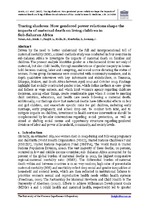| dc.description.abstract | Driven by the need to better understand the full and intergenerational toll of maternal mortality (MM), a mixed-methods study was conducted in four countries in sub-Saharan Africa to investigate the impacts of maternal death on families and children. The present analysis identifies gender as a fundamental driver not only of maternal, but also child health, through manifestations of gender inequity in house- hold decision making, labor and caregiving, and social norms dictating the status of women. Focus group discussions were conducted with community members, and in depth qualitative interviews with key- informants and stakeholders, in Tanzania, Ethiopia, Malawi, and South Africa between April 2012 and October 2013. Findings highlight that socially constructed gender roles, which define mothers as care- givers and fathers as wage earners, and which limit women's agency regarding childcare decisions, among other things, create considerable gaps when it comes to meeting child nutrition, education, and health care needs following a maternal death. Additionally, our findings show that maternal deaths have differential effects on boy and girl children, and exacerbate specific risks for girl children, including early marriage, early pregnancy, and school drop-out. To combat both MM, and to mitigate impacts on children, investment in health services interventions should be complemented by broader interventions regarding social protection, as well as aimed at shifting social norms and opportunity structures regarding gendered divisions of labor and power at household, community, and society levels. | en_US |

